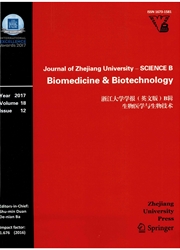

 中文摘要:
中文摘要:
For a long time,classification of Demodex mites has been based mainly on their hosts and phenotypic characteristics.A new subspecies of Demodex folliculorum has been proposed,but not confirmed.Here,cox1 partial sequences of nine isolates of three Demodex species from two geographical sources(China and Spain) were studied to conduct molecular identification of D.folliculorum.Sequencing showed that the mitochondrial cox1 fragments of five D.folliculorum isolates from the facial skin of Chinese individuals were 429 bp long and that their sequence identity was 97.4%.The average sequence divergence was 1.24% among the five Chinese isolates,0.94% between the two geographical isolate groups(China(5) and Spain(1)),and 2.15% between the two facial tissue sources(facial skin(6) and eyelids(1)).The genetic distance and rate of third-position nucleotide transition/transversion were 0.0125,2.7(3/1) among the five Chinese isolates,0.0094,3.1(3/1) between the two geographical isolate groups,and 0.0217,4.4(3/1) between the two facial tissue sources.Phylogenetic trees showed that D.folliculorum from the two geographical isolate groups did not form sister clades,while those from different facial tissue sources did.According to the molecular characteristics,it appears that subspecies differentiation might not have occurred and that D.folliculorum isolates from the two geographical sources are of the same population.However,population differentiation might be occurring between isolates from facial skin and eyelids.
 英文摘要:
英文摘要:
For a long time,classification of Demodex mites has been based mainly on their hosts and phenotypic characteristics.A new subspecies of Demodex folliculorum has been proposed,but not confirmed.Here,cox1 partial sequences of nine isolates of three Demodex species from two geographical sources(China and Spain) were studied to conduct molecular identification of D.folliculorum.Sequencing showed that the mitochondrial cox1 fragments of five D.folliculorum isolates from the facial skin of Chinese individuals were 429 bp long and that their sequence identity was 97.4%.The average sequence divergence was 1.24% among the five Chinese isolates,0.94% between the two geographical isolate groups(China(5) and Spain(1)),and 2.15% between the two facial tissue sources(facial skin(6) and eyelids(1)).The genetic distance and rate of third-position nucleotide transition/transversion were 0.0125,2.7(3/1) among the five Chinese isolates,0.0094,3.1(3/1) between the two geographical isolate groups,and 0.0217,4.4(3/1) between the two facial tissue sources.Phylogenetic trees showed that D.folliculorum from the two geographical isolate groups did not form sister clades,while those from different facial tissue sources did.According to the molecular characteristics,it appears that subspecies differentiation might not have occurred and that D.folliculorum isolates from the two geographical sources are of the same population.However,population differentiation might be occurring between isolates from facial skin and eyelids.
 同期刊论文项目
同期刊论文项目
 同项目期刊论文
同项目期刊论文
 期刊信息
期刊信息
